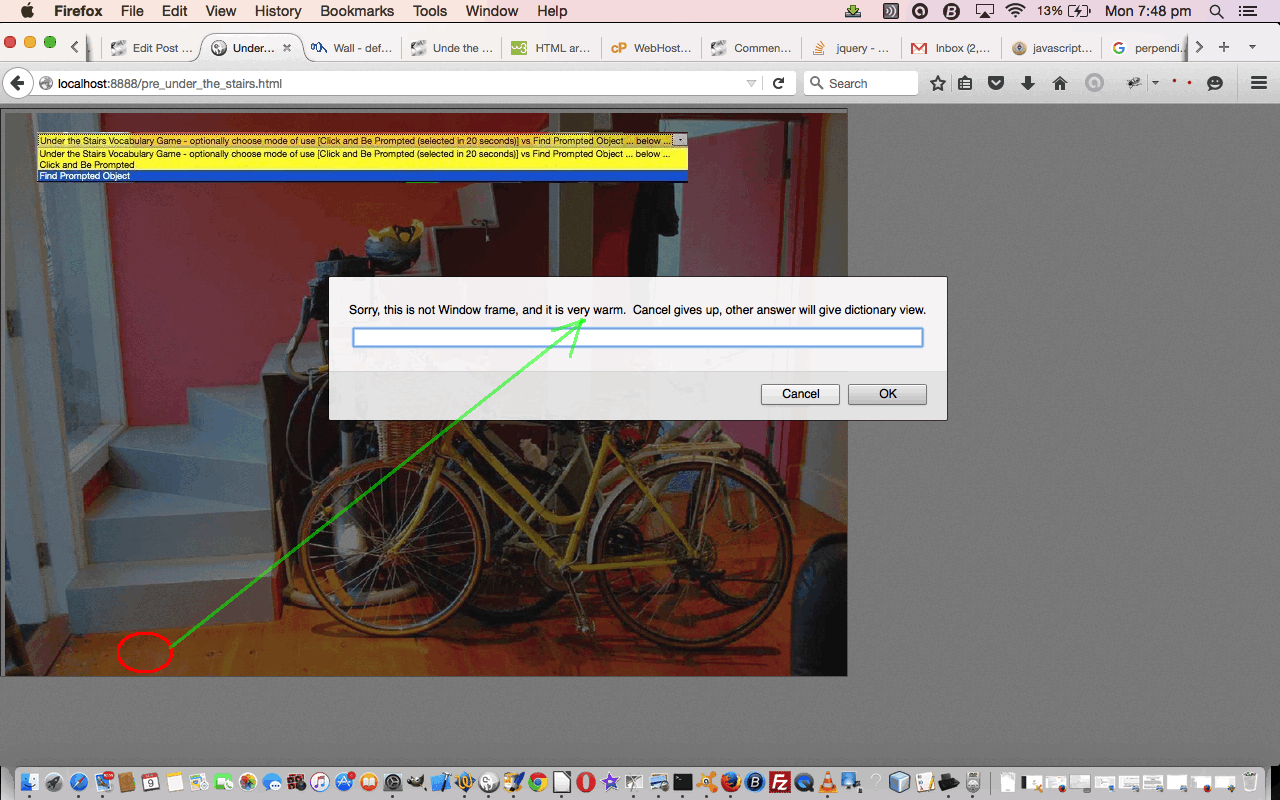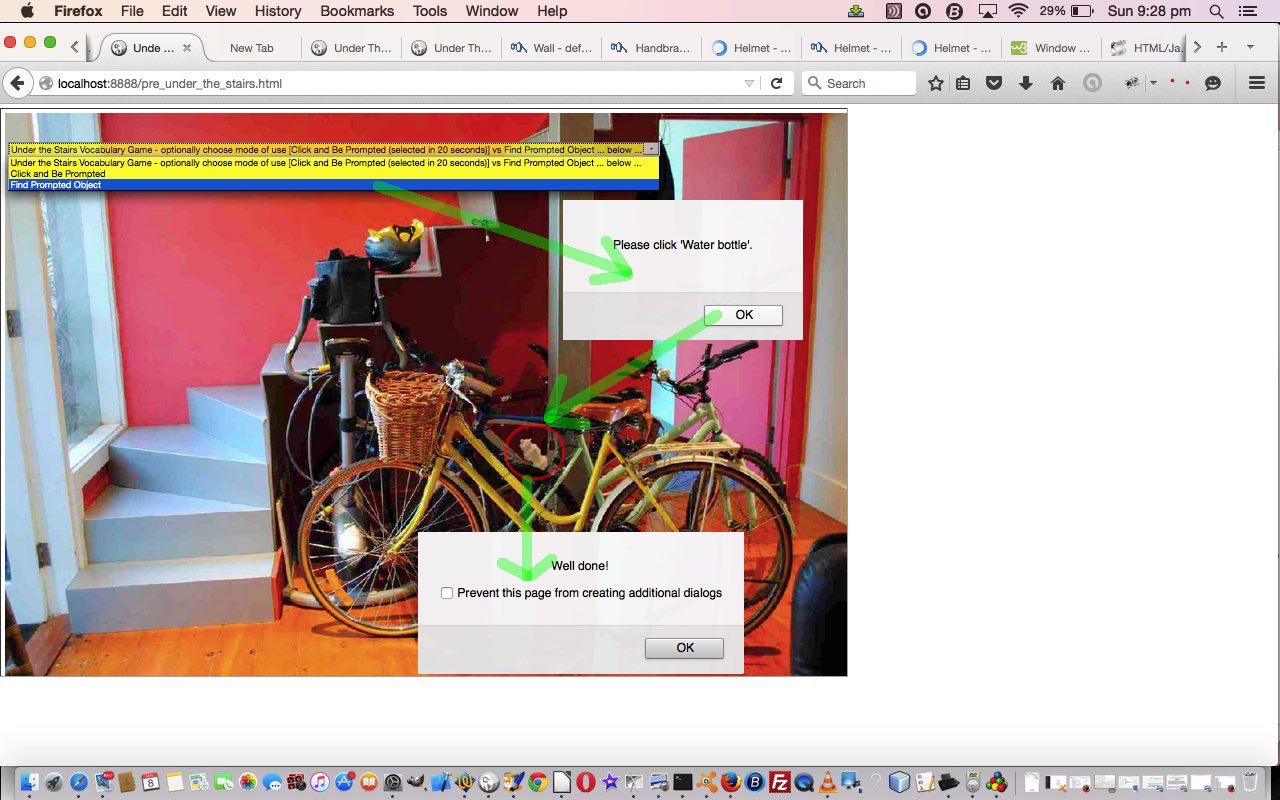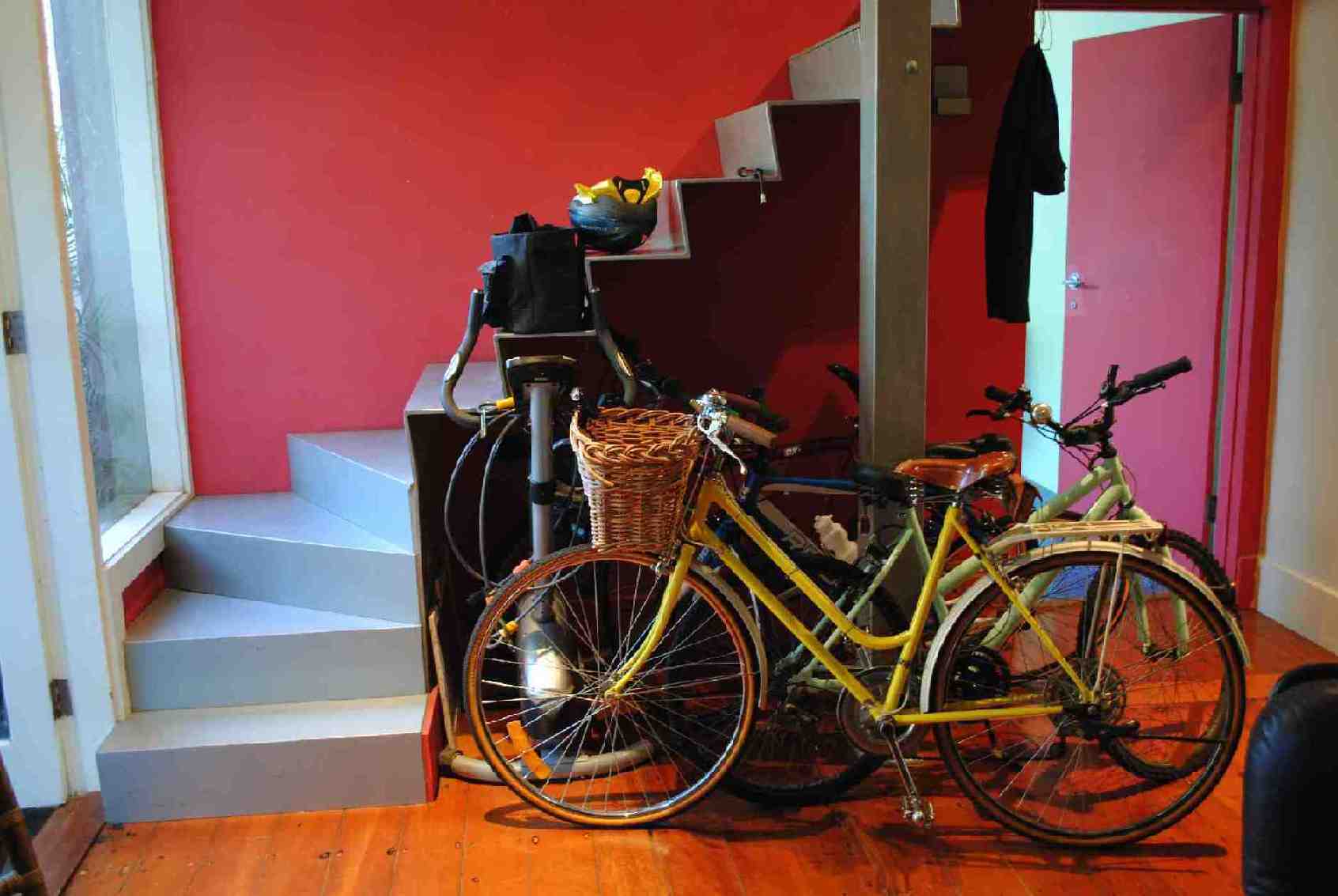As we saw yesterday, the HTML map element can be used in a variety of ways, two of which we hone in on with today’s ESL Vocabulary Getting Warmer Game Tutorial, a variation on yesterday’s ESL Under The Stairs Game Overlay Primer Tutorial as shown below, where we add Javascript functionality to effectively find the shortest distance of a point to a polygon co-ordinate “set”, and a revisit of our previous English Learning – Vocabulary – Under The Stairs as shown way below. The HTML map element can be …
- a jigsaw “overlay” to the underlying image (in that we try to cover the whole area of the image with clickable HTML area “polygon” segments (the so called “Click and be Prompted” mode of use)) … but if the user selects a “Find Prompted Object” mode of use that same HTML map element is reworked to become like …
- a “Where’s Wally” scenario where the computer prompts the user for what they should click on, where the HTML map element has one defined HTML area tag plus one other default “nonhref” HTML area tag
In that second mode of use today, we add a bit of fun by adding that “getting warmer” type of “bizzo” (sorry to get technical) to our game.
To do this, as we’ve mentioned, we find the shortest distance of a point to a polygon co-ordinate “set” by …
- leave the HTML map to determine when a point is inside its first “polygon” section, and for all the rest, via that other “nohref” HTML area element’s onclick event, we arrange some Javascript that …
- breaks the problem into sets of 3 co-ordinate (x,y) arrangements for each polygon line segment (brought up to 3 by the point chosen by the user) …
- for each of these consider the three points as a triangle and use Heron’s Formula to calculate the triangle area
function herons_formula_triangle_area(x1, y1, x2, y2, x3, y3) {
var a=Math.sqrt((x1 - x2) * (x1 - x2) + (y1 - y2) * (y1 - y2));
var b=Math.sqrt((x3 - x2) * (x3 - x2) + (y3 - y2) * (y3 - y2));
var c=Math.sqrt((x3 - x1) * (x3 - x1) + (y3 - y1) * (y3 - y1));
var s=eval((a + b + c) / 2.0);
return Math.sqrt(s * (s - a) * (s - b) * (s - c));
}
- the base value in “area=base x height / 2″ (area of a triangle) can be calculated as the line segment length (square root of the x co-ordinate difference squared plus the y co-ordinate difference squared)
function find_dist(x1, y1, x2, y2) {
return Math.sqrt((x1 - x2) * (x1 - x2) + (y1 - y2) * (y1 - y2));
}
- so height=area x 2 / base …
function calcdist() {
var theseobjs, area=0.0, base=0.0, height=0.0, smallestijh=-1;
var thesexy;
eval("aconto.getElementById('" + midis + "').title='other';");
smallesth=-1.0;
theseobjs=objects[snum].split(';');
thesexy=theseobjs[1].split(',');
for (var ijh=2; ijh<eval(-2 + (thesexy.length / 1)); ijh+=2) {
area=herons_formula_triangle_area(x, y, thesexy[eval(-2 + ijh)], thesexy[eval(-1 + ijh)], thesexy[ijh], thesexy[eval(1 + ijh)]);
base=find_dist(thesexy[eval(-2 + ijh)], thesexy[eval(-1 + ijh)], thesexy[ijh], thesexy[eval(1 + ijh)]);
height=eval((2.0 * area) / base);
if (eval(height) < eval(smallesth) || eval(smallesth) < 0.0) {
smallesth=height;
}
}
var cnf;
if (eval(smallesth) < 3) {
cnf=prompt("Sorry, this is not " + thisobj + ", and it is boiling. Cancel gives up, other answer will give dictionary view.","");
} else if (eval(smallesth) < 10) {
cnf=prompt("Sorry, this is not " + thisobj + ", and it is very hot. Cancel gives up, other answer will give dictionary view.","");
} else if (eval(smallesth) < 20) {
cnf=prompt("Sorry, this is not " + thisobj + ", and it is very warm. Cancel gives up, other answer will give dictionary view.","");
} else if (eval(smallesth) < 40) {
cnf=prompt("Sorry, this is not " + thisobj + ", and it is warm. Cancel gives up, other answer will give dictionary view.","");
} else if (eval(smallesth) < 80) {
cnf=prompt("Sorry, this is not " + thisobj + ", and it is lukewarm. Cancel gives up, other answer will give dictionary view.","");
} else if (eval(smallesth) < 120) {
cnf=prompt("Sorry, this is not " + thisobj + ", and it is cool. Cancel gives up, other answer will give dictionary view.","");
} else if (eval(smallesth) < 160) {
cnf=prompt("Sorry, this is not " + thisobj + ", and it is cold. Cancel gives up, other answer will give dictionary view.","");
} else if (eval(smallesth) < 160) {
cnf=prompt("Sorry, this is not " + thisobj + ", and it is freezing. Cancel gives up, other answer will give dictionary view.","");
}
if (cnf == null) {
eval("aconto.getElementById('" + midis + "').title='';");
} else {
if (cnf.length == 0) {
cnf=cnf;
return true;
} else {
eval("aconto.getElementById('" + midis + "').title='lookup';");
}
}
return false;
}
- and our shortest distance can be thought of as the smallest of these “height” values (and you can see how we did this above)
… and then the concept of “boiling” vs “very warm” etcetera etcetera should be worked out by trying it out (with alert box help).
Again, with today’s work, we are in the area of study of “overlay”, the HTML map tag being a well established overlay method linking image data with co-ordinate intelligence, still a useful idea we think.
HTML and Javascript codewise the original under_the_stairs.html is unchanged from the way it was way below, but today, with our changed scenario, it is used within an HTML iframe element using our Client Pre-emptive Iframe techniques to glean HTML map information, and then reworked as necessary directly into that iframe, and the HTML and Javascript for this is pre_under_the_stairs.html changed from yesterday as per this link.
This could all become very much clearer when you try a live run and we hope it leaves you with some ideas to try out yourself in a project you are working on.
Previous relevant ESL Under The Stairs Game Overlay Primer Tutorial is shown below.
The HTML map element can be used in a variety of ways, two of which we hone in on with today’s ESL Vocabulary game “Under the Stairs”, a revisit of our previous English Learning – Vocabulary – Under The Stairs is shown below, where that same HTML map element used then, today, starts as …
- a jigsaw “overlay” to the underlying image (in that we try to cover the whole area of the image with clickable HTML area “polygon” segments (the so called “Click and be Prompted” mode of use)) … but if the user selects a “Find Prompted Object” mode of use that same HTML map element is reworked to become like …
- a “Where’s Wally” scenario where the computer prompts the user for what they should click on, where the HTML map element has one defined HTML area tag plus one other default “nonhref” HTML area tag
Again, we are in the area of study of “overlay”, the HTML map tag being a well established overlay method linking image data with co-ordinate intelligence, still a useful idea we think.
HTML and Javascript codewise the original under_the_stairs.html is unchanged from the way it was below, but today, with our changed scenario, it is used within an HTML iframe element using our Client Pre-emptive Iframe techniques to glean HTML map information, and then reworked as necessary directly into that iframe, and the HTML and Javascript for this is pre_under_the_stairs.html channeling those oft-mentioned CSS techniques …
- position:absolute property
- z-index
- opacity
The “overlay” concept comes into play, too, for the user to control the mode of use of the web application (ie. its HTML map element’s mode of use) via an HTML select tag “overlayed” on top of an HTML iframe element which exists that way for 20 seconds allowing the user to choose that other mode of use should they be interested.
This could all become much clearer when you try a live run and we hope it leaves you with some ideas to try out yourself in a project you are working on.
Previous relevant English Learning – Vocabulary – Under The Stairs is shown below.
Click to start class. How many things can you name?
If this was interesting you may be interested in this too.
If this was interesting you may be interested in this too.
If this was interesting you may be interested in this too.






Yay google is my king helped me to locate this outstanding site! .
How to upload a template that was made in dreamweaver to my joomla site?
What i don’t realize is if truth be told how you are no longer really a lot more well-liked than you might be now. You’re very intelligent. You understand thus considerably relating to this topic, made me in my opinion imagine it from numerous numerous angles. Its like women and men are not fascinated unless it is something to do with Lady gaga! Your individual stuffs outstanding. Always handle it up!
As I look at the major courses for both it seems that I can take screen writing and film courses as my general major elective as a English major. When I choose a minor which can be creative writing or film studies, I’m having a hard time because I want to pursue a career as a screenwriter for film as a secondary job for myself, but wouldn’t Creative Writing help me with that?.
Unquestionably effective standpoint, thanks for writing.. Undoubtedly helpful outlook, many thanks for blogging.. Adoring the contribution.. thanks for your insight Excellent views you have here..
My web searches seem total.. thanks. Terrific thought processes you’ve got here.. Wonderful thoughts you have here.. My personal web surfing seem complete.. thank you.
My personal searches seem total.. thanks. Love the posting you presented.. Honestly useful outlook, appreciate your posting.. Is not it wonderful any time you come across a fantastic publish?
Good blog you have got here.. It’s difficult to find excellent writing like yours nowadays.
I honestly appreciate people like you! Take care!!
Thanks
Hiya, I’m really glad I’ve found this info. Nowadays bloggers publish just about gossips and internet and this is actually frustrating. A good website with interesting content, this is what I need. Thank you for keeping this web site, I’ll be visiting it. Do you do newsletters? Can’t find it.